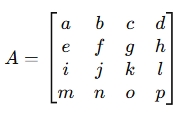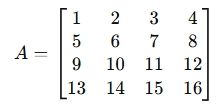4x4 fourth-order matrix determinant calculator
|
| |||||||||||||||||
| Results: | |
| Determinant of a matrix (|A|)= | |
What is a 4×4 Fourth-Order Matrix Determinant Calculator?
A 4×4 Fourth-Order Matrix Determinant Calculator is a tool that calculates the determinant of a given 4×4 matrix. The determinant is a scalar value that provides important insights into the properties of a matrix, such as its invertibility, rank, and its ability to solve systems of linear equations.
For a given 4×4 matrix:

The determinant is computed using a recursive approach (expanding along rows or columns) or by performing row operations to reduce the matrix to a simpler form. For a 4×4 matrix, the calculation involves expanding it into smaller 3×3 matrices, and then calculating their determinants recursively.
Why Use a 4×4 Matrix Determinant Calculator?
- Matrix Properties – The determinant tells you whether a matrix is invertible (non-zero determinant) or singular (zero determinant).
- System Solvability – A zero determinant indicates that the system of equations represented by the matrix has no unique solution or infinite solutions.
- Geometric Interpretation – The determinant can represent scaling factors in space, like the volume change when applying a linear transformation.
- Applications:
- In Linear Algebra – To solve systems of linear equations.
- In Physics & Engineering – For analyzing forces, energy, and systems of equations.
- In Computer Science – For operations involving matrices such as in computer graphics or neural networks.
- In Economics & Data Science – For understanding matrices in econometrics or data transformation.
How Does It Work?
- Input a 4×4 matrix.
- Expand the determinant using cofactor expansion, usually along the first row or first column.
For example, the determinant of a 4×4 matrix is given by:
det(A)=a⋅det(A11)−b⋅det(A12)+c⋅det(A13)−d⋅det(A14)Where A11, A12 , A13 , and A14 are the 3×3 submatrices obtained by removing the respective row and column of the element you're expanding around.
- Calculate the determinant of the smaller 3×3 matrices recursively, and repeat the process until you reduce the matrix to smaller determinants.
Example Calculation
For the matrix:

To calculate the determinant:

Then you would calculate each of the 3×3 determinants and sum them up.
When to Use It?
- In solving systems of linear equations – To check if a system of equations has a unique solution (non-zero determinant) or not (zero determinant).
- In geometry – To calculate the volume or scaling factors in transformations.
- In physics and engineering – For stability analysis, force distribution, and system modeling.
- In economics and data science – For econometric models and matrix factorization.